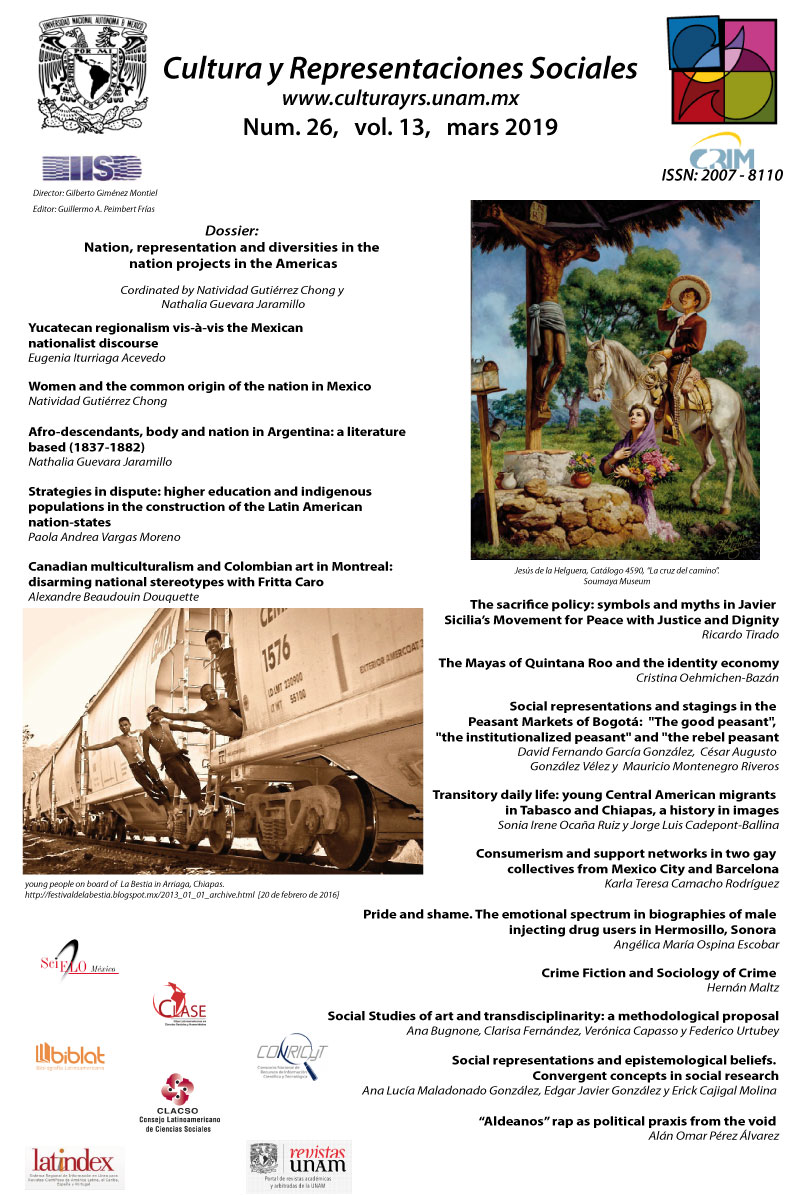Abstract
Based on biographical stories compiled in 2015 of injected drug users, an analysis is made of fluctuations between pride and shame as indicators of the quality of social ties at different moments in the trajectories of drug use among two groups of men. The condition of impoverishment and violence faced by the participants during their childhood generated feelings of shame and inadequacy. Throughout their biographies, the subjects seek to build new narratives of themselves in order to compensate the injuries generated by the early feeling of shame. Belonging to deviant groups and the use of drugs are strategies which allow them to gain status and power. However, with the consolidation of the trajectories of drug use, the emotional cost of carrying the stigma of the “addicted” and the social detachment were amplified. The analysis of the participants' socio-emotional experience makes it possible to visualize the mechanisms through which the stigma of drug use is internalized, and the strategies used by the subjects to administer it, as well as the social anchors that make it possible to carry out less risky drug use dynamics.References
Amery, Jean (2013). Más allá de la culpa y la expiación. Tentativas de superación de una víctima de la violencia. Barcelona: Pre-textos.
Ariza, Marina (2016). “La sociología de las emociones como plataforma para la investigación social”. En Emociones, afectos y sociología: Diálogos desde la investigación social y la interdisciplina, coordinado por Marina Ariza, 7-36. México: UNAM, Instituto de Investigaciones Sociales.
Ariza, Marina (2016a). “Tonalidades emocionales en la experiencia de la migración laboral. Humillación y degradación social”. En Emociones, afectos y sociología: Diálogos desde la investigación social y la interdisciplina, coordinado por Marina Ariza, 279-328. México: UNAM, Instituto de Investigaciones Sociales.
Ariza, Marina (2017). “Vergüenza, orgullo y humillación: Los contrapuntos emocionales en la experiencia femenina de la migración laboral femenina”. Estudios Sociológicos XXXV (103):65-89
Becker, Howard (2009). Outsiders. Hacia una sociología de la desviación. Buenos Aires: Siglo XXI Editores.
Becker, Howard (2016). Cómo fumar marihuana y tener un buen viaje. Una mirada sociológica. Buenos Aires: Siglo XXI Editores.
Bertaux, Daniel (1983). “From the Life-History Approach to the Transformation of Sociological Practice” En Biography and Society. The Life History Approach in the Social Sciences, compilado por Daniel Bertaux. Berkeley: Sage Publications
Bloch, Charlotte (2002). “Managing the emotions of competition and recognition in Academia” En Emotions and Sociology, editado por Jack Barbalet, 113-131. Oxford: Blackwell Publishing
Chase, Susan (2005). “Narrative Inquiry. Multiple lenses, approaches, voices”. En Collecting and interpreting qualitative materials, editado por Norman Denzin e Yvonna Lincoln, 57-94. Oaks: Sage Publications.
Collins, Randall (2004) Interaction Ritual Chains. Oxford: Oxford University Press
Consejo Nacional de Evaluación de la Política de Desarrollo Social (Coneval, 2017). Pobreza en México. Resultados de pobreza en México 2016 a nivel nacional y por entidades federativas. https://www.coneval.org.mx/Medicion/Paginas/PobrezaInicio.aspx
Cooley, Charles (1922). Human Nature and the Social Order. New York: Scribner’s
Goffman, Erving (1971). La presentación de la persona en la vida cotidiana. Buenos Aires: Amorrortu Editores.
Goffman, Erving (2006). Estigma. La identidad deteriorada. Buenos Aires: Amorrortu Editores.
Hochschild, Arlie Russell (1983). The Managed Heart: Commercialization of Human Feeling. Berkeley: University of California Press
Instituto Nacional de Estadística y Geografía (INEGI, 2015). Escolaridad. Disponible en http://cuentame.inegi.org.mx/poblacion/escolaridad.aspx?tema=P [Consulta: 10 Febrero 2018].
Kemper, Theodore (1991). “Predicting emotions from social relations”. Social Psychology Quartely 54(4):330-342.
Kemper, Theodore (2006). “Power and Status and the Power-Status theory of emotions”. En Handbook of the sociology of emotions, compilado por Jonathan Turner y Jan Stets, 87-113. Nueva York: Springer.
Kemper, Theodore (2011). “Status, Power and Ritual Interaction. A relational reading of Durkheim, Goffman and Collins”. Nueva York: Routledge.
Kemper, Theodore (2017). Elementary forms of social relations. Status, Power and reference groups. Nueva York: Routledge.
Lewis, Helen. (1971). Shame and guilt in neurosis. Nueva York: International Universities Press.
Martínez Salgado, Carolina (2012). “El muestreo en investigación cualitativa. Principios básicos y algunas controversias”. Ciencia & Saude Colectiva, 17 (3):613-619
Matza, David y Sykes, Gresham (1961). “Juvenile delinquency and subterranean values”. American Sociological Review, 26 (5):712-719
Merton, Robert (1938). “Social structure and anomie”. American Sociological Review, 3 (5): 672-682
Ospina Escobar, Angélica (2016). Itinerarios de adversidad. Biografías de uso de drogas, estilos de vida y ambientes de riesgo al VIH en varones inyectores de Tijuana, Cd. Juárez y Hermosillo, México. Tesis de doctorado en Estudios de Población. México: El Colegio de México.
Peláez González, Carolina (2016). “Un mar de vergüenza y asco” En Emociones, afectos y sociología: Diálogos desde la investigación social y la interdisciplina, coordinado por Marina Ariza, 149-192. México: UNAM, Instituto de Investigaciones Sociales.
Pugliesi, Karen (2010). “Deviation in emotion and the labeling of mental illness”. Deviant Behavior, 8 (1): 79-102
Reguillo, Rossana (2012). “Memories of the future”. Young, 20 (4): 345-355
Romaní, Oriol (2008). “Políticas de drogas: prevención, participación y reducción del daño”. Salud colectiva, 4 (3): 301-318.
Scheff, Thomas (1974). “The Labelling Theory of Mental Illness”. American Sociological Review, 39 (3): 444-452
Scheff, Thomas (1988). “Shame and conformity: The deference-emotion system”. American Sociological Review, 53(3):395-406
Scheff, Thomas (2000). “Shame and social bond”. Sociological Theory, 18(1): 84-99
Scheff, Thomas (2003). “Male emotions/relationships and violence. A Case Study”. Human Relations, 56 (6):727-749
Scheff, Thomas y Retzinger, Suzanne (1991). Emotions and violence: Shame and rage in destructive conflicts. Lincoln: iUniverse, Inc
Secretaría de Salud, Instituto Nacional de Psiquiatría Ramón de la Fuente Muñiz, Instituto Nacional de Salud Pública; Comisión Nacional contra las Adicciones (2017). Encuesta Nacional de Drogas, Alcohol y Tabaco 2016-2017. https://www.gob.mx/cms/uploads/attachment/file/234856/CONSUMO_DE_DROGAS.pdf [Fecha de consulta: 25/09/2018].
Shields, Stephanie; Garner, Dallas; DiLeone, Brooke; y Hadley, Alena(2007). “Gender and Emotion”. En Handbook of the Sociology of Emotions, compilado por Jonathan Turner y Jan Stets, 63-86. Nueva York: Springer.
Simmel, Georg (2010). El secreto y las sociedades secretas. Madrid: Sequitur
Simmel, Georg (2018). “Sobre una psicología de la vergüenza”[artículo en línea]. Traducido por Andrés Soto. Digithum, 21: 67-74. [Fecha de consulta: 25/09/2018].
Summers-Effler, Erika (2006.) “Defensive Strategies: The Formation and Social Implication of Patterned Self-destructive Behavior”. Theory and Research on Human Emotions. Advances in Group Processes, 21:309-325
Thoits, Peter (1985). “Self-Labeling Processes in Mental Illness: The Role of Emotional Deviance”. American Journal of Sociology, 91 (2): 221-249
Tomkins, Silvan (1992) Affect, imagery, Consciousness: Vol II, The negative affects. New York: Springer.
Turner, Jonathan y Stests, Jan (2006). “Moral Emotions”. En Handbook of the Sociology of Emotions, compilado por Jonathan Turner y Jan Stets, 544-566. Nueva York: Springer.
Turner, Jonathan. (2010). “The stratification of emocions: Some preliminary generalizations”. Sociological inquiry 80 (2): 168-199.
Weber, Max (1953). Economía y sociedad. México: Fondo de Cultura Económica
Licencia Creative Commons Revista Cultura y Representaciones Sociales / Universidad Nacional Autónoma de México se distribuye bajo una Licencia Creative Commons Atribución 4.0 Internacional (CC-BY 4.0)



